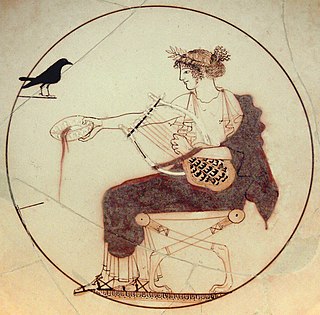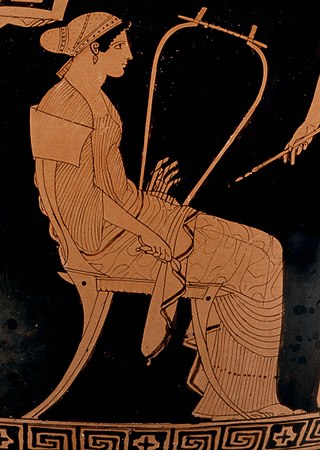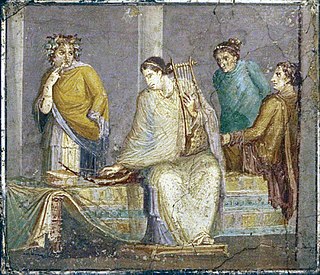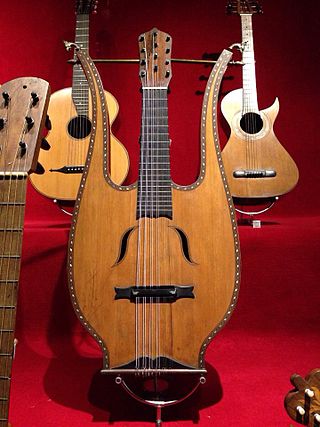
The glockenspiel or bells is a percussion instrument consisting of pitched aluminum or steel bars arranged in a keyboard layout. This makes the glockenspiel a type of metallophone, similar to the vibraphone.

The lyre is a stringed musical instrument that is classified by Hornbostel–Sachs as a member of the lute family of instruments. In organology, a lyre is considered a yoke lute, since it is a lute in which the strings are attached to a yoke that lies in the same plane as the sound table, and consists of two arms and a crossbar.

The rebec is a bowed stringed instrument of the Medieval era and the early Renaissance. In its most common form, it has a narrow boat-shaped body and one to five strings.
Lira is the unit of currency of various countries.

The lijerica is a musical instrument from the Croatian region of Dalmatia and Croat parts of eastern Herzegovina. It is a pear-shaped, three-stringed instrument which is played with a bow. It is played to accompany the traditional linđo dance from the region. The lijerica's name comes from the lyra, the bowed instrument of the Byzantine Empire which it probably evolved from.

The chelys or chelus, was a stringed musical instrument, the common lyre of the ancient Greeks, which had a convex back of tortoiseshell or of wood shaped like the shell. The word chelys was used in allusion to the oldest lyre of the Greeks, which was said to have been invented by Hermes. According to the Homeric Hymn to Hermes, he came across a tortoise near the threshold of his mother's home and decided to hollow out the shell to make the soundbox of an instrument with seven strings.

The barbiton, or barbitos, is an ancient stringed instrument related to the lyre known from Greek and Roman classics.
The Lyre of Orpheus may refer to:

The talharpa (pine-harp), also known as a tagelharpa, hiiu kannel or stråkharpa, is a two to four stringed bowed lyre from northern Europe. It is questionable whether it was formerly common and widespread in Scandinavia. Historically, it has been played in the Estonian-Swedish areas and in Western Estonia, particularly among Estonian Swedes who came to Estonia around the 10th century from the Swedish part of Finland; they likely brought the instrument with them It is similar to the Finnish jouhikko and the Welsh crwth. Jouhikko, a close relative of talharpa, is still known in Finland.

The kithara, or Latinized cithara, was an ancient Greek musical instrument in the yoke lutes family. It was a seven-stringed professional version of the lyre, which was regarded as a rustic, or folk instrument, appropriate for teaching music to beginners. As opposed to the simpler lyre, the cithara was primarily used by professional musicians, called kitharodes. In modern Greek, the word kithara has come to mean "guitar", a word which etymologically stems from kithara.

The Byzantine lyra or lira was a medieval bowed string musical instrument in the Byzantine Empire. In its popular form, the lyra was a pear-shaped instrument with three to five strings, held upright and played by stopping the strings from the side with fingernails. The first known depiction of the instrument is on a Byzantine ivory casket, preserved in the Bargello in Florence. Versions of the Byzantine lyra are still played throughout the former lands of the Byzantine Empire: Greece, Crete, Albania, Montenegro, Serbia, Bulgaria, North Macedonia, Croatia, Italy and Armenia.

The Cretan lyra is a Greek pear-shaped, three-stringed bowed musical instrument, central to the traditional music of Crete and other islands in the Dodecanese and the Aegean Archipelago, in Greece. The Cretan lyra is considered to be the most popular surviving form of the medieval Byzantine lyra, an ancestor of most European bowed instruments.

Antonis Papadakis, or Kareklas (1893–1980) was a Cretan musician and famous for his superb lyra performance. He was born in Pervolia, Rethymno, then part of the Ottoman Empire. He started playing the lyra since he was a kid. He is considered one of the most important lyra performers of the early 20th century. When he started playing lyra the laouto was not yet established as an accompanying instrument of the lyre in Crete. Thus, he was occasionally using the string instrument boulgari as accompanying instrument, popular at that time in the Rethymnon. Bouzouki was a typical accompanying instrument for lyra at that time.

A musical instrument of the chordophone family, the lyre-guitar was a type of guitar shaped to look like a lyre, popular as a fad-instrument in the late 1800s. It had six single courses, with a fretboard located between two curved arms recalling the shape of the ancient Greek kithara. It was tuned and played like the conventional guitar.
Greek musical instruments were grouped under the general term "all developments from the original construction of a tortoise shell with two branching horns, having also a cross piece to which the stringser from an original three to ten or even more in the later period, like the Byzantine era". Greek musical instruments can be classified into the following categories:
The Kemençe of the Black Sea is a Greek and Turkish traditional musical instrument. It belongs to the category of stringed bowed musical instruments. It has three strings, usually tuned to perfect fourths, usually tuned B-E-A. It is the pre-eminent musical folk instrument of the Greeks of Pontus. It seems to have been invented during the Byzantine years, between the 11th and 12th centuries. The instrument is made of different types of wood.

The classicalkemenche, Armudî kemençe or Politiki lyra is a pear-shaped bowed instrument that derived from the medieval Greek Byzantine lyre.
Yoke lutes, commonly called lyres, are a class of string instruments, subfamily of lutes, indicated with the code 321.2 in the Hornbostel–Sachs classification.












